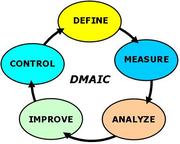Six Sigma
A Basic Overview of Six Sigma
Six Sigma is the single most efficient problem-solving methodology for improving business, organizational, and even personal performance. Simply stated, Six Sigma is about applying a structured, scientific method to improve any aspect of a business, organization, process or person. It’s about engaging in disciplined data collection and analysis to determine the best possible ways of meeting your customer’s needs while satisfying yours, and minimizing wasted resources and maximizing profit in the process. Six Sigma is applicable everywhere: it’s applicable not only in large and complex corporations but also in the less complex and more intimate worlds of professional performance and personal accomplishment.
The Six Sigma philosophy is based on the principle that all work is a process. A process may be drilling a hole; answering a phone call; cutting a tree; landing an airplane; driving a nail; performing a surgery; filling out a form, and so forth. Six Sigma’s goal is to reduce variations in a process to a level that results in almost no errors or mistakes. Every error or mistake has a cost associated with it, sometimes the cost is small and other times the cost of an error is huge. Cost of Quality is the term typically used for the cost associated with mistakes or errors. Six Sigma performance is the statistical term for a process that produces fewer than 3.4 defects or errors or mistakes per million opportunities.
Six Sigma relies on a simple, yet powerful systematic approach to improvement known as the DMAIC process. DMAIC is an acronym for:
DEFINE – Understand and describe what is required or desired and be able to express that goal in a measurable fashion.MEASURE – Measure what the current process is doing.
ANALYZE – Evaluate the process measurements and develop a plan for what needs to be changed to improve it.
IMPROVE – Execute the plan for improvement and measure to verify that it is giving the desired results.
CONTROL – Implement a method to keep the improved performing as designed and periodically measure it to be sure it has not changed.
The DMAIC is not a “straight-line” process – it is a cycle. After reaching the Control stage, the cycle should return to the Define stage and determine if the process can be further improved. If additional improvements are possible and can be justified, the DMAIC process begins again, and continues through cycle-by-cycle with the goal being process perfection.
Six Sigma uses a set of quality management methods, including statistical methods, as well as a special infrastructure of people within the organization known as Black Belts, Green Belts, and Yellow Belts who are experts in these methods
Six Sigma takes discipline and effort and above all, change. It’s not an easy journey, but the transformational results are improved performance, lower costs, happier customers, and SUCCESS!
